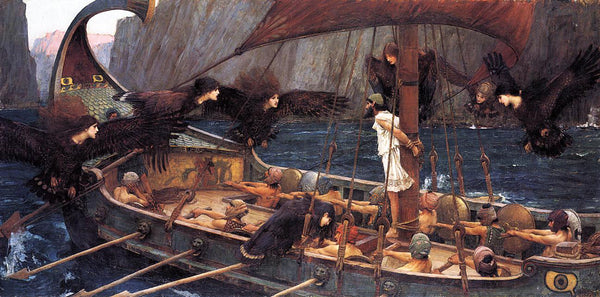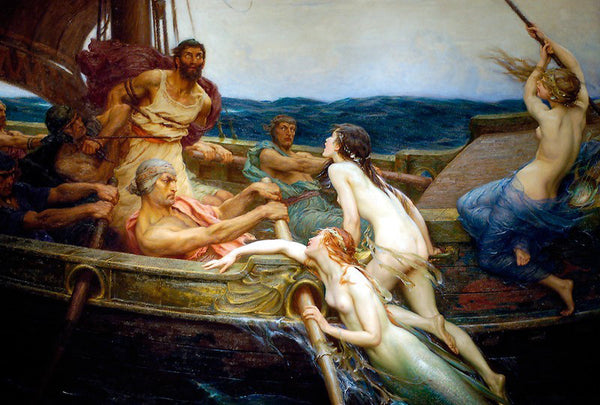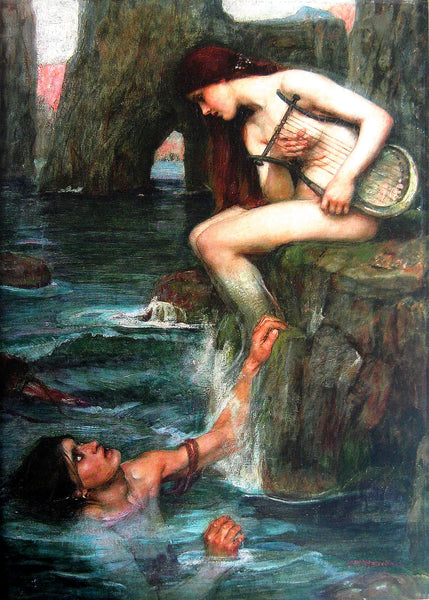Siren Spotlight: on the nature of sirens April 27, 2017 10:57
Today's blog contains images of nudity in the form of classical paintings.
From Jess:
"Rescue Sirens" went from a vague idea about maybe developing something with lifeguard mermaids to a book series and an entire world when I was standing in my living room one day and heard the wailing of a rescue vehicle from the fire station down the street. "Rescue Sirens," I thought. "That's what you'd call lifeguard mermaids!"
I love terrible puns and wordplay, so I laughed at my own dorky joke... and then I couldn't get it out of my head. That's when questions began bubbling to the surface. What if these mermaids worked as lifeguards because they were sworn to an ancient vow to protect humans? What if living topside for a time was a requirement for all mermaids as soon as they came of age? What if they had to keep their identities a secret from the humans they lived amongst? I was intrigued and delighted by the possibilities. The more I thought about it, the more things fit together; the more it started to sound like a world.
As a fan of mythology, I was well aware that the classical Sirens were originally depicted as bird-women, but I also knew that the definition of the term had broadened over the centuries to include fish-women -- in other words, mermaids. I thought that this was universally accepted.
Boy, was I wrong!
While most people don't take issue with the concept of the word "siren" being a synonym for "mermaid" (or even give it a second thought), there's a vocal minority who objects to the very title of our series. A few weeks back, I ran an ad on Instagram, which exposed "Rescue Sirens" to a wider audience than usual... with some surprising results. I've chosen my favorite responses, presented here without comment:





Whew!
There are two main issues here: that sirens are bird-women, not mermaids; and that sirens are seductive, evil, and bloodthirsty. I'll address each separately.
#1. "Sirens are bird-women, not mermaids!"
I totally understand wanting to set the record straight when you feel that something's inaccurate. As a tiny bespectacled know-it-all child, I would vehemently correct anyone who used the term "killer whale," insisting, "NO, they're not killer whales, they're orcas, because they're actually the largest species of dolphin" -- but it's not always that simple.
As I later learned, the animal known as Orcinus orca was originally referred to by sailors as "whale killer" for its habit of hunting baleen whales, but the word order was switched over time to "killer whale," which is still in use today. (And yes, while orcas are classified as dolphins, all dolphins are also technically toothed whales, so they are whales in the more general sense. Mini-Jess was just being pedantic.) Language is a living thing, as fluid as the waters in which our Rescue Sirens swim, and things change.
Similarly, the definition for the word "siren" has expanded to include not only the bird-women of Ancient Greece, but also the mythological fish-women that we recognize as mermaids. How the heck did that happen? Some people point to the Catholic Church, which depicted seductive sirens as women with sinuous lower bodies like that of snakes or fish -- often the double-tailed version that you've seen on your Starbucks coffee cup -- out of a desire to avoid confusing sirens with Heaven's winged angels. Still others blame an error in translation. Whatever the reasons, referring to mermaids as "sirens" stuck.
Bird-women...

"Ulysses and the Sirens," John William Waterhouse (1891)
...and mermaids:

"Ulysses and the Sirens," Herbert James Draper (1909)
Pre-Raphaelite painter John William Waterhouse, who, in 1891, painted the Sirens tormenting Ulysses in their bird-women forms as you see above, produced the following image of a fish-legged Siren perched at the water's edge about a decade later:

"The Siren," John William Waterhouse (1900)
It's not just artists who began choosing the mermaid-siren over the bird-siren. Modern examples (besides "Rescue Sirens," that is!) include Disney's film "Pirates of the Caribbean: On Stranger Tides," with its mermaid character, Syrena; and the upcoming Freeform television series "Siren," which is about -- you guessed it -- a mermaid.
Even more compellingly, the word for "mermaid" in both Spanish and Italian is "sirena," while the French word is "sirène."
And, with my background in marine mammal husbandry, I'd be remiss in failing to mention the manatee and the dugong, the humble sea cows that are thought by many to be the biological inspiration for mermaid myths. The name of their scientific order? Sirenia.
Although the word "siren" may have initially referred to mythical women with bird features, today, it is also synonymous with "mermaid," which is why our lifeguard mermaid series is called "Rescue Sirens."
(Besides, "Rescue Mermaids" just sounds silly.)
#2. "Sirens don't help humans; they lure sailors to their deaths!"
This one's pretty straightforward. No illustrations needed!
The classical Sirens were originally depicted as seductive and deadly. We aren't playing by those rules, however; we've created our own distinctive twist. In "Rescue Sirens"' unique mythology, all humans originated from mermaids who stayed dry in their two-legged form too long, losing their ability to transform back and live in the sea -- so the remaining mermaids swore a solemn vow to forever watch over their landlocked kin. When a mermaid comes of age, she goes to live topside, pledged to protect, learn, and teach; it's at this time that she earns the rank of "Rescue Siren."
Insisting that all sirens are "supposed" to be deadly is like insisting that all ghosts are "supposed" to be scary, including the titular character in "Casper the Friendly Ghost." The distinction is right there in the title: the word "rescue" in "Rescue Sirens" lets you know that, if you're under the impression that sirens are inherently evil, these ones are different.
If this Siren Spotlight has demonstrated anything, it's that the evolution of language is absolutely fascinating!
We're not here to define the word "siren" for everyone; we're simply defining how we use it in our book series, based on one popular interpretation of a fantasy term: in "Rescue Sirens," the words "siren" and "mermaid" are used interchangeably to refer to the same creature (the way cougars are also known as panthers, pumas, mountain lions, or catamounts), and our Rescue Sirens are not hostile toward humans.
Outside of the "Rescue Sirens" property, though, we recognize and respect that other people's preferences and opinions differ. That diversity is part of what makes mermaid stories so much fun!
From Jess:
"Rescue Sirens" went from a vague idea about maybe developing something with lifeguard mermaids to a book series and an entire world when I was standing in my living room one day and heard the wailing of a rescue vehicle from the fire station down the street. "Rescue Sirens," I thought. "That's what you'd call lifeguard mermaids!"
I love terrible puns and wordplay, so I laughed at my own dorky joke... and then I couldn't get it out of my head. That's when questions began bubbling to the surface. What if these mermaids worked as lifeguards because they were sworn to an ancient vow to protect humans? What if living topside for a time was a requirement for all mermaids as soon as they came of age? What if they had to keep their identities a secret from the humans they lived amongst? I was intrigued and delighted by the possibilities. The more I thought about it, the more things fit together; the more it started to sound like a world.
As a fan of mythology, I was well aware that the classical Sirens were originally depicted as bird-women, but I also knew that the definition of the term had broadened over the centuries to include fish-women -- in other words, mermaids. I thought that this was universally accepted.
Boy, was I wrong!
While most people don't take issue with the concept of the word "siren" being a synonym for "mermaid" (or even give it a second thought), there's a vocal minority who objects to the very title of our series. A few weeks back, I ran an ad on Instagram, which exposed "Rescue Sirens" to a wider audience than usual... with some surprising results. I've chosen my favorite responses, presented here without comment:





Whew!
There are two main issues here: that sirens are bird-women, not mermaids; and that sirens are seductive, evil, and bloodthirsty. I'll address each separately.
#1. "Sirens are bird-women, not mermaids!"
I totally understand wanting to set the record straight when you feel that something's inaccurate. As a tiny bespectacled know-it-all child, I would vehemently correct anyone who used the term "killer whale," insisting, "NO, they're not killer whales, they're orcas, because they're actually the largest species of dolphin" -- but it's not always that simple.
As I later learned, the animal known as Orcinus orca was originally referred to by sailors as "whale killer" for its habit of hunting baleen whales, but the word order was switched over time to "killer whale," which is still in use today. (And yes, while orcas are classified as dolphins, all dolphins are also technically toothed whales, so they are whales in the more general sense. Mini-Jess was just being pedantic.) Language is a living thing, as fluid as the waters in which our Rescue Sirens swim, and things change.
Similarly, the definition for the word "siren" has expanded to include not only the bird-women of Ancient Greece, but also the mythological fish-women that we recognize as mermaids. How the heck did that happen? Some people point to the Catholic Church, which depicted seductive sirens as women with sinuous lower bodies like that of snakes or fish -- often the double-tailed version that you've seen on your Starbucks coffee cup -- out of a desire to avoid confusing sirens with Heaven's winged angels. Still others blame an error in translation. Whatever the reasons, referring to mermaids as "sirens" stuck.
Bird-women...

"Ulysses and the Sirens," John William Waterhouse (1891)
...and mermaids:

"Ulysses and the Sirens," Herbert James Draper (1909)
Pre-Raphaelite painter John William Waterhouse, who, in 1891, painted the Sirens tormenting Ulysses in their bird-women forms as you see above, produced the following image of a fish-legged Siren perched at the water's edge about a decade later:

"The Siren," John William Waterhouse (1900)
It's not just artists who began choosing the mermaid-siren over the bird-siren. Modern examples (besides "Rescue Sirens," that is!) include Disney's film "Pirates of the Caribbean: On Stranger Tides," with its mermaid character, Syrena; and the upcoming Freeform television series "Siren," which is about -- you guessed it -- a mermaid.
Even more compellingly, the word for "mermaid" in both Spanish and Italian is "sirena," while the French word is "sirène."
And, with my background in marine mammal husbandry, I'd be remiss in failing to mention the manatee and the dugong, the humble sea cows that are thought by many to be the biological inspiration for mermaid myths. The name of their scientific order? Sirenia.
Although the word "siren" may have initially referred to mythical women with bird features, today, it is also synonymous with "mermaid," which is why our lifeguard mermaid series is called "Rescue Sirens."
(Besides, "Rescue Mermaids" just sounds silly.)
#2. "Sirens don't help humans; they lure sailors to their deaths!"
This one's pretty straightforward. No illustrations needed!
The classical Sirens were originally depicted as seductive and deadly. We aren't playing by those rules, however; we've created our own distinctive twist. In "Rescue Sirens"' unique mythology, all humans originated from mermaids who stayed dry in their two-legged form too long, losing their ability to transform back and live in the sea -- so the remaining mermaids swore a solemn vow to forever watch over their landlocked kin. When a mermaid comes of age, she goes to live topside, pledged to protect, learn, and teach; it's at this time that she earns the rank of "Rescue Siren."
Insisting that all sirens are "supposed" to be deadly is like insisting that all ghosts are "supposed" to be scary, including the titular character in "Casper the Friendly Ghost." The distinction is right there in the title: the word "rescue" in "Rescue Sirens" lets you know that, if you're under the impression that sirens are inherently evil, these ones are different.
If this Siren Spotlight has demonstrated anything, it's that the evolution of language is absolutely fascinating!
We're not here to define the word "siren" for everyone; we're simply defining how we use it in our book series, based on one popular interpretation of a fantasy term: in "Rescue Sirens," the words "siren" and "mermaid" are used interchangeably to refer to the same creature (the way cougars are also known as panthers, pumas, mountain lions, or catamounts), and our Rescue Sirens are not hostile toward humans.
Outside of the "Rescue Sirens" property, though, we recognize and respect that other people's preferences and opinions differ. That diversity is part of what makes mermaid stories so much fun!
